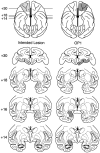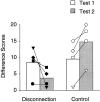Control of response selection by reinforcer value requires interaction of amygdala and orbital prefrontal cortex
- PMID: 10818166
- PMCID: PMC6772657
- DOI: 10.1523/JNEUROSCI.20-11-04311.2000
Control of response selection by reinforcer value requires interaction of amygdala and orbital prefrontal cortex
Abstract
Goal-directed actions are guided by expected outcomes of those actions. Humans with bilateral damage to ventromedial prefrontal cortex, or the amygdala, are deficient in their ability to use information about positive and negative outcomes to guide their choice behavior. Similarly, rats and monkeys with orbital prefrontal or amygdala damage have been found to be impaired in their responses to changing values of outcomes. In the present study, we tested whether direct, functional interaction between the amygdala and the orbital prefrontal cortex is necessary for guiding behavior based on expected outcomes. Unlike control monkeys, rhesus monkeys with surgical disconnection of these two structures, achieved by crossed unilateral lesions of the amygdala in one hemisphere and orbital prefrontal cortex in the other, combined with forebrain commissurotomy, were unable to adjust their choice behavior after a change in the outcome (here, a reduction in the value of a particular reinforcer). The lesions did not affect motivation to work for a food reinforcer, or food preferences, per se. Hence, the amygdala and orbital prefrontal cortex act as part of an integrated neural system guiding decision-making and adaptive response selection.
Figures






References
-
- Adolphs R, Tranel D, Damasio AR. The human amygdala in social judgment. Nature. 1998;393:470–474. - PubMed
-
- Aggleton JP, Passingham RE. Syndrome produced by lesions of the amygdala in monkeys (Macaca mulatta). J Comp Physiol Psychol. 1981;95:961–977. - PubMed
-
- Aggleton JP, Passingham RE. An assessment of the reinforcing properties of foods after amygdaloid lesions in rhesus monkeys. J Comp Physiol Psychol. 1982;96:71–77. - PubMed
-
- Amaral DG, Price JL. Amygdalo-cortical projections in the monkey (Macaca fascicularis). J Comp Neurol. 1984;230:465–496. - PubMed
-
- Amaral DG, Price JL, Pitkänen A, Carmichael ST. Anatomical organization of the primate amygdaloid complex. In: Aggleton JP, editor. The amygdala: neuropsychological aspects of emotion, memory, and mental dysfunction. Wiley-Liss; New York: 1992. pp. 1–66.
Publication types
MeSH terms
LinkOut - more resources
Full Text Sources
Other Literature Sources
